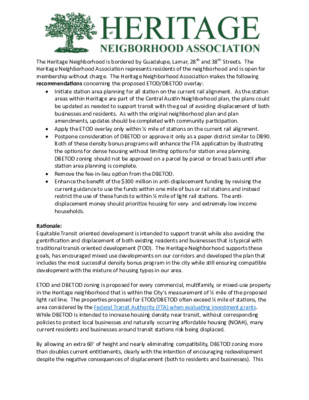02 Additional Public Correspondence.pdf — original pdf
Backup

The Heritage Neighborhood is bordered by Guadalupe, Lamar, 28th and 38th Streets. The Heritage Neighborhood Associa@on represents residents of the neighborhood and is open for membership without charge. The Heritage Neighborhood Associa@on makes the following recommenda)ons concerning the proposed ETOD/DBETOD overlay: • Ini@ate sta@on area planning for all sta@on on the current rail alignment. As the sta@on areas within Heritage are part of the Central Aus@n Neighborhood plan, the plans could be updated as needed to support transit with the goal of avoiding displacement of both businesses and residents. As with the original neighborhood plan and plan amendments, updates should be completed with community par@cipa@on. • Apply the ETOD overlay only within ½ mile of sta@ons on the current rail alignment. • Postpone considera@on of DBETOD or approve it only as a paper district similar to DB90. Both of these density bonus programs will enhance the FTA applica@on by illustra@ng the op@ons for dense housing without limi@ng op@ons for sta@on area planning. DBETOD zoning should not be approved on a parcel by parcel or broad basis un@l aSer sta@on area planning is complete. • Remove the fee-in-lieu op@on from the DBETOD. • Enhance the benefit of the $300 million in an@-displacement funding by revising the current guidance to use the funds within one mile of bus or rail sta@ons and instead restrict the use of these funds to within ½ mile of light rail sta@ons. The an@- displacement money should priori@ze housing for very- and extremely-low income households. Ra)onale: Equitable Transit oriented development is intended to support transit while also avoiding the gentrifica@on and displacement of both exis@ng residents and businesses that is typical with tradi@onal transit-oriented development (TOD). The Heritage Neighborhood supports these goals, has encouraged mixed use developments on our corridors and developed the plan that includes the most successful density bonus program in the city while s@ll ensuring compa@ble development with the mixture of housing types in our area. ETOD and DBETOD zoning is proposed for every commercial, mul@family, or mixed-use property in the Heritage neighborhood that is within the City’s measurement of ½ mile of the proposed light rail line. The proper@es proposed for ETOD/DBETOD oSen exceed ½ mile of sta@ons, the area considered by the Federal Transit Authority (FTA) when evalua@ng investment grants. While DBETOD is intended to increase housing density near transit, without corresponding policies to protect local businesses and naturally occurring affordable housing (NOAH), many current residents and businesses around transit sta@ons risk being displaced. By allowing an extra 60’ of height and nearly elimina@ng compa@bility, DBETOD zoning more than doubles current en@tlements, clearly with the inten@on of encouraging redevelopment despite the nega@ve consequences of displacement (both to residents and businesses). This zoning is being applied without first developing sta@on area plans as expected by the FTA. Without sta@on area plans, the score for Transit-Suppor@ve Corridor Policies will be LOW. If the DBETOD zoning is granted it will be impossible do sta@on area plans. Once the en@tlements for 100’ to 120’ tall buildings are granted, Aus@n Transit Partnership will lose the needed flexibility to plan for the right mix of uses and housing types at each sta@on. The solid circle on the map shows the ½ mile radius around the sta@ons. The FTA expects to see planning to ensure that transit will be accessible to very low and extremely low income residents. DBETOD instead encourages taller buildings which likely means that transit dependent riders in small mul@family proper@es will be displaced and replaced with higher income residents who can afford to live in newer, taller buildings. The Heritage neighborhood has many small mul@family proper@es and two larger ones with units that are less than 400 sq S. As these proper@es are NOAH, redevelopment should be avoided. As income is the best predictor of transit use, this gentrifica@on nega@vely impacts ridership. The ra@onal for the ETOD overlay is that it will make the FTA grant applica@on more compe@@ve. The ETOD study report on page 13 claims that this objec@ve is premised on the Contract with the Voters. But the contract with the voters said nothing about compe@@veness or land use changes. There is no need to fast-track zoning changes. Setting up new entitlements through the DBETOD at the Project Development stage is not needed to meet "Medium" requirements for getting FTA approval for the next stage, which is Engineering, and which cannot start for over a year. We have very narrow streets in Heritage and this kind of extreme re-zoning should come with some means of addressing water runoff/property retention and infrastructure issues. What Austin needs for approval of 50% funding by FTA at the stage of actual construction of the line is an average over 9 criteria of "Medium High". That stage will need to show plans and tools in place to encourage environmentally sound development with affordable housing (both legally and market provided), reduced auto traffic, improved mode share for transit and non- auto modes, a premier pedestrian environment to reach the stations with in the 1/2 mile radius. This will be needed in about 2.5 years, not today.